What better way to welcome spring with open arms than with this Lemon Asparagus Pasta? It’s bright, zingy, packed with delightful spring flavor and an amazing sauce.
The creamy sauce is made with a combination of olive oil, pasta water, and walnuts, creating a velvety texture that will leave you wanting more. And the best part? It’s naturally dairy-free and vegan!
As soon as asparagus comes into season, this lemon asparagus pasta recipe is a must-try. It’s fresh, flavorful, and perfect for any occasion. Whether you’re looking for a quick weeknight meal or a fancy dinner party dish, this recipe is sure to impress. So grab your apron and let’s get cooking!
Table of Contents:
1. Why this recipe works
2. Ingredient notes and substitutions
3. Step by step instructions
4. Tips for making this recipe
5. Frequently Asked Questions
6. Recipe card with notes
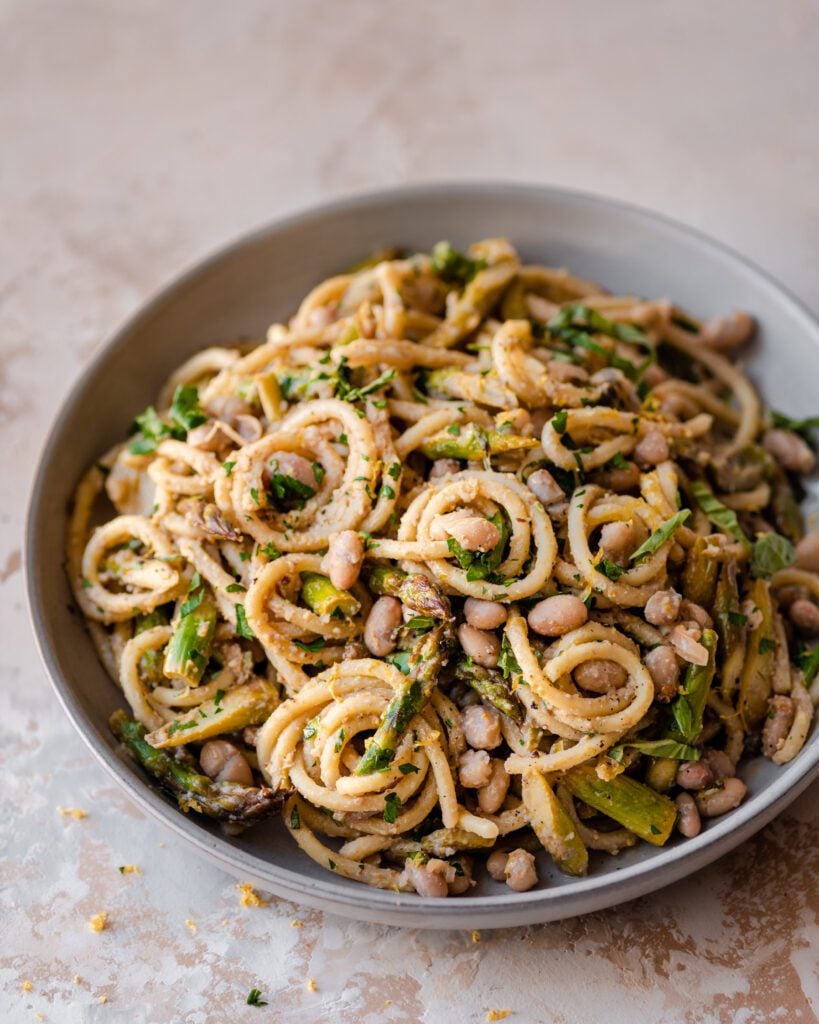
Why this recipe works
Perfect marriage of spring flavors.
Inspired by Evan Funke’s Spaghetti al Limone, this pasta has all the best flavors of spring.
With the juice and zest of two whole lemons, this pasta is delightfully lemony, while the addition of basil and parsley lends it an herbaceous note. Capers and olives add a zingy, briny flavor (but feel free to leave them out if you prefer), while the crushed walnuts provide a slight nuttiness. And of course, we can’t forget the star of the show – asparagus, the king of spring!
A great way to cook asparagus
In season asparagus doesn’t need much help to taste amazing. Here, asparagus gets lightly pan-fried in olive oil alongside shallots, garlic, and lemon zest. The result is a wonderful crisp-tender texture, which is a nice contrast with the creamy pasta.
Gourmet but easy
This is the kind of dish you might find at a fancy restaurant but it’s simple to make at home! With prep time included, you can get this dish on the table in 45 minutes.
Ingredient notes and substitutions
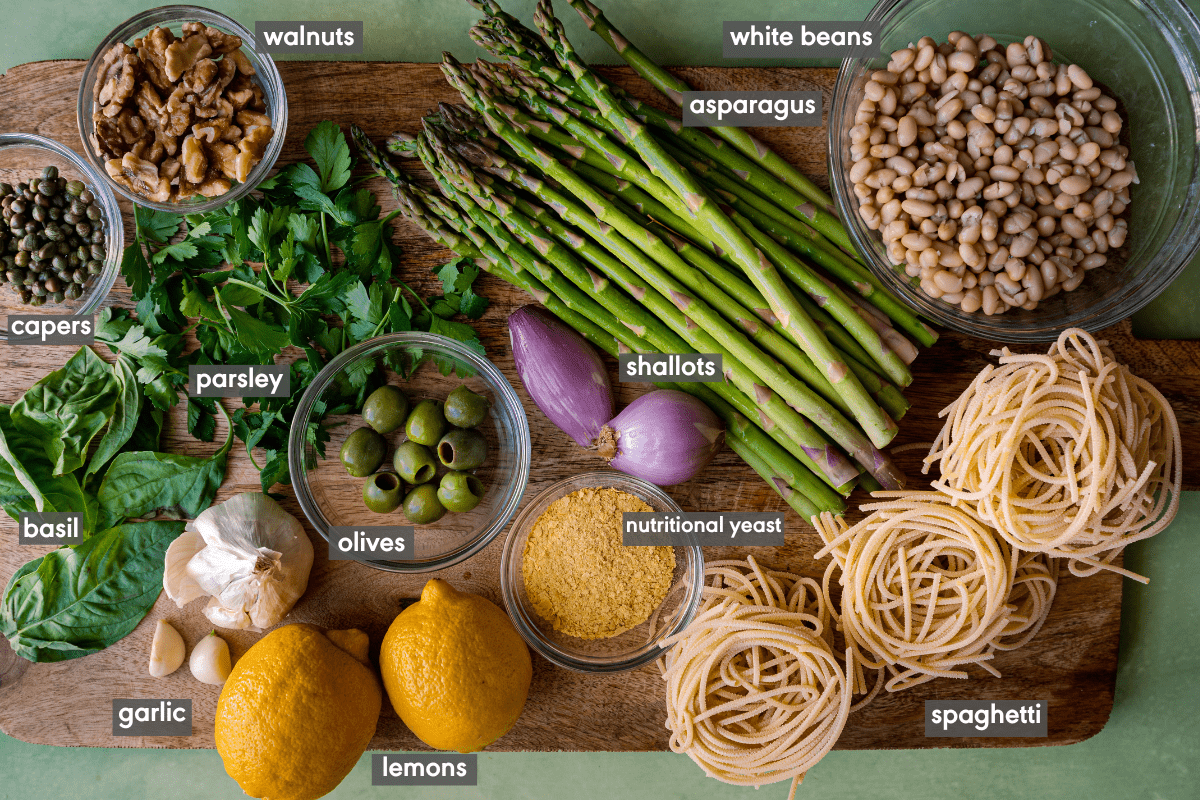
Asparagus
One of my favorite spring vegetables, it works wonderfully here alongside the other flavors. If it’s not in season where you are, feel free to swap it out for another green vegetable. Broccoli, brussel sprouts, or even legumes like green beans or snap peas would work well here.
Spaghetti
Spaghetti is the classic pasta option here but any noodle or ribbon shaped pasta would work well here (fettucine, bucatini, linguine, etc.).
Walnuts
Walnuts are a fantastic plant-based source of umami. Here, they get finely ground which helps them cling to the olive oil sauce, much in the same way parmesan cheese does. Alongside the nutritional yeast, walnuts provide a great savory backbone to this dish.
Olives and Capers (optional)
I know olives can be divisive, so please feel free to leave them out if you can’t stand them. But Castelvetrano olives–the olives in this recipe–are very mild in flavor so you might want to give them a try.
Extra Virgin Olive Oil
Use a good-quality extra virgin olive oil, as it’s the primary ingredient in the sauce. Good quality doesn’t need to be expensive though (I used the California Olive Ranch extra virgin olive oil (affiliate link) – a great olive oil for everyday use).
White beans
While the dish is still satisfying without them, white beans are an optional ingredient that provides some serious heft and protein. Don’t have white beans? Navy beans would also be a fine choice.
How to make this recipe
Trim the asparagus and discard the tough woody ends. Slice each asparagus spear deeply on the diagonal into pieces (about 1/2 to 1 inch).
Make the Lemon Sauce. Juice the two lemons into a jar. Add the Dijon mustard, extra virgin olive oil, and salt/pepper. Shake vigorously until emulsified. Or, whisk all the ingredients together in a bowl.
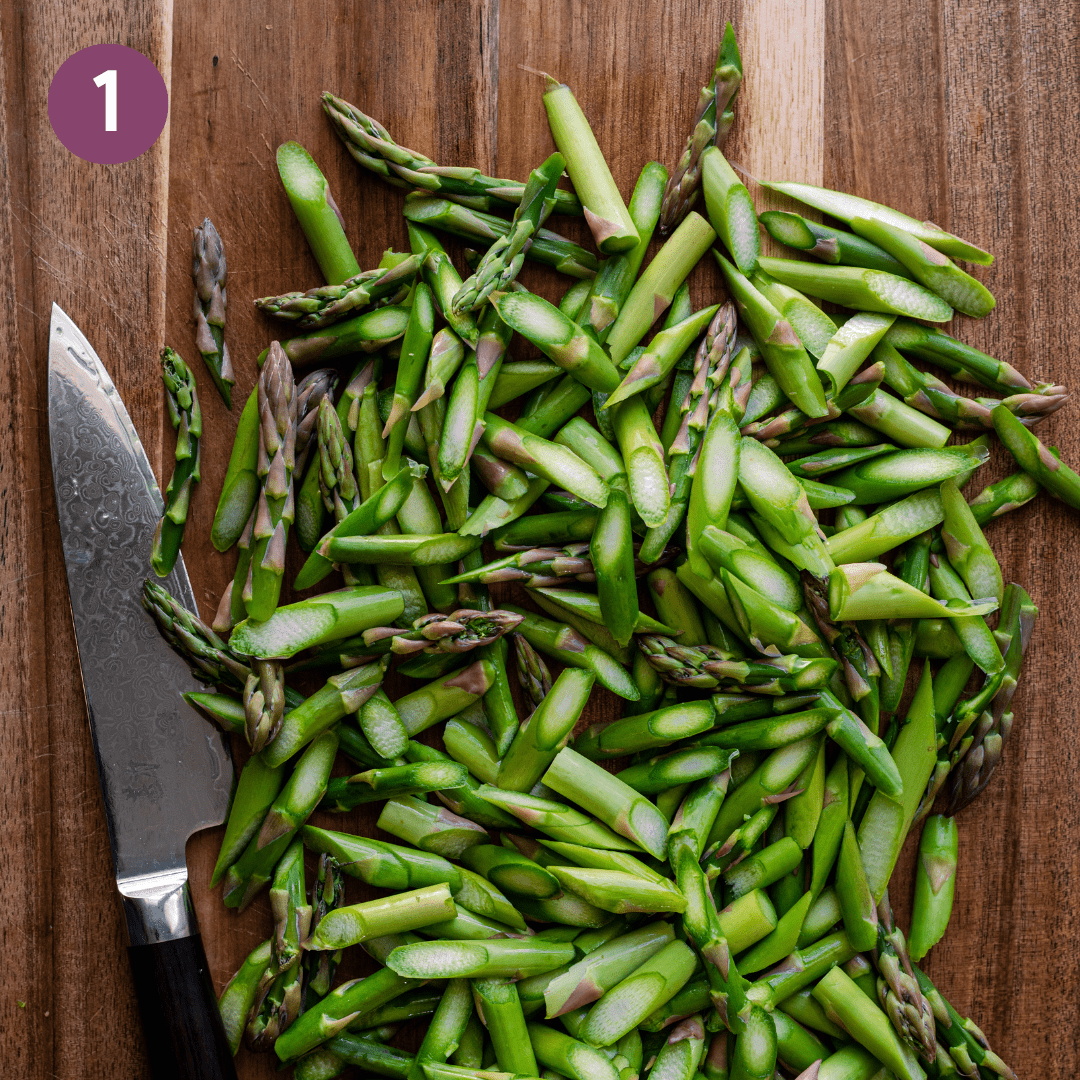
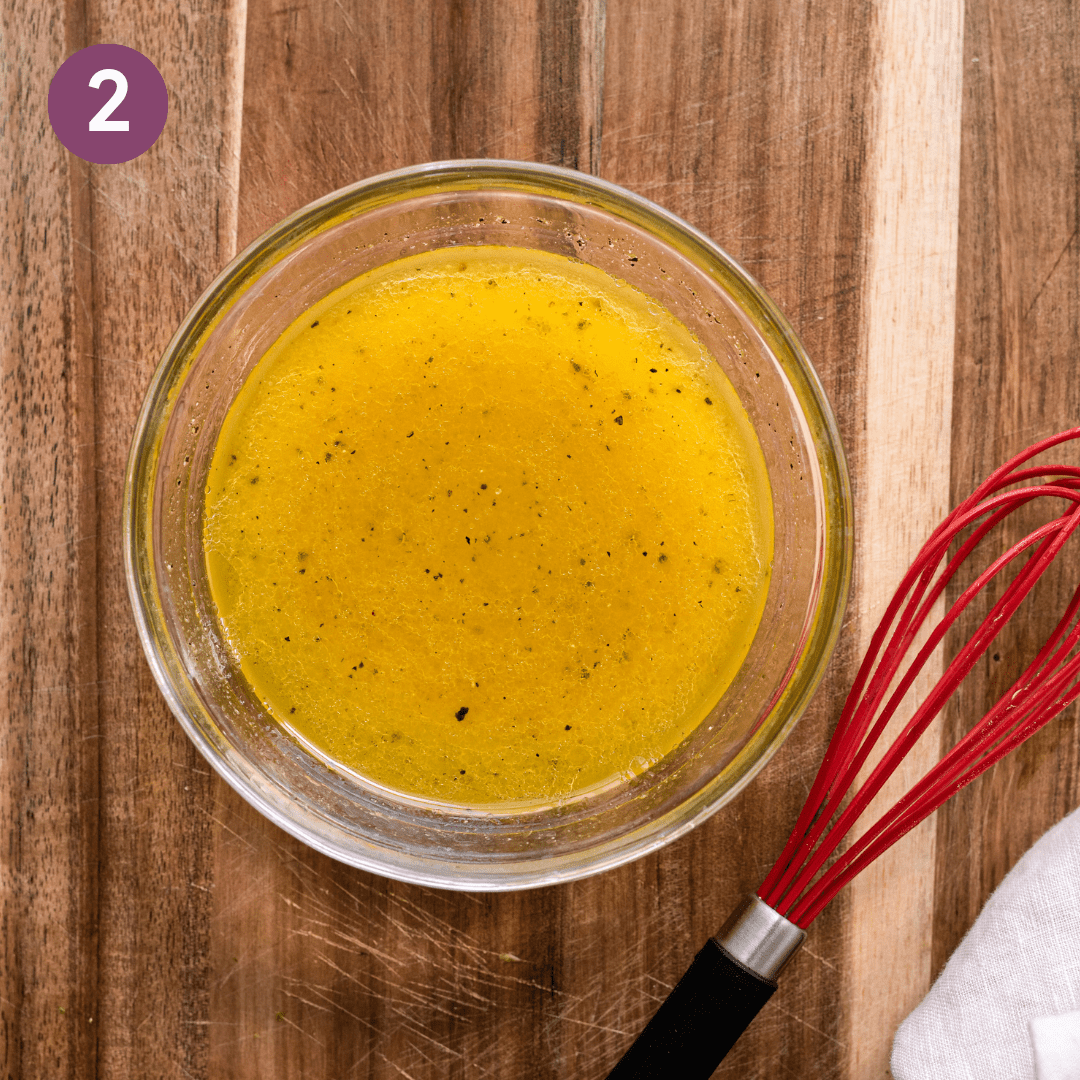
Heat a bit of extra virgin olive oil in a 12-inch sauté pan (or Dutch oven). Cook the sliced shallots and garlic cloves until golden. Add the red pepper flakes (if using) for 30 seconds.
Add the sliced asparagus and half of the lemon zest (from one lemon).
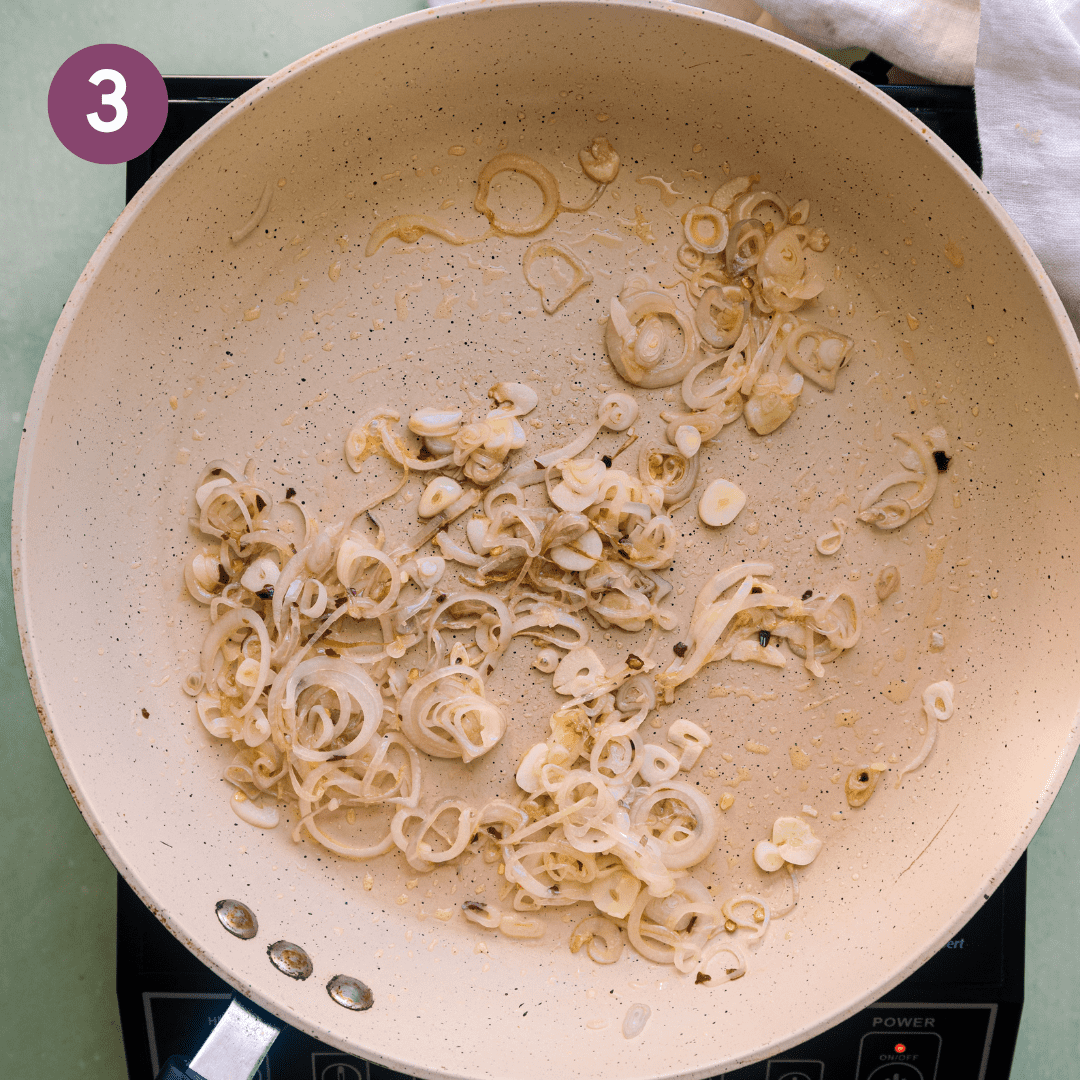
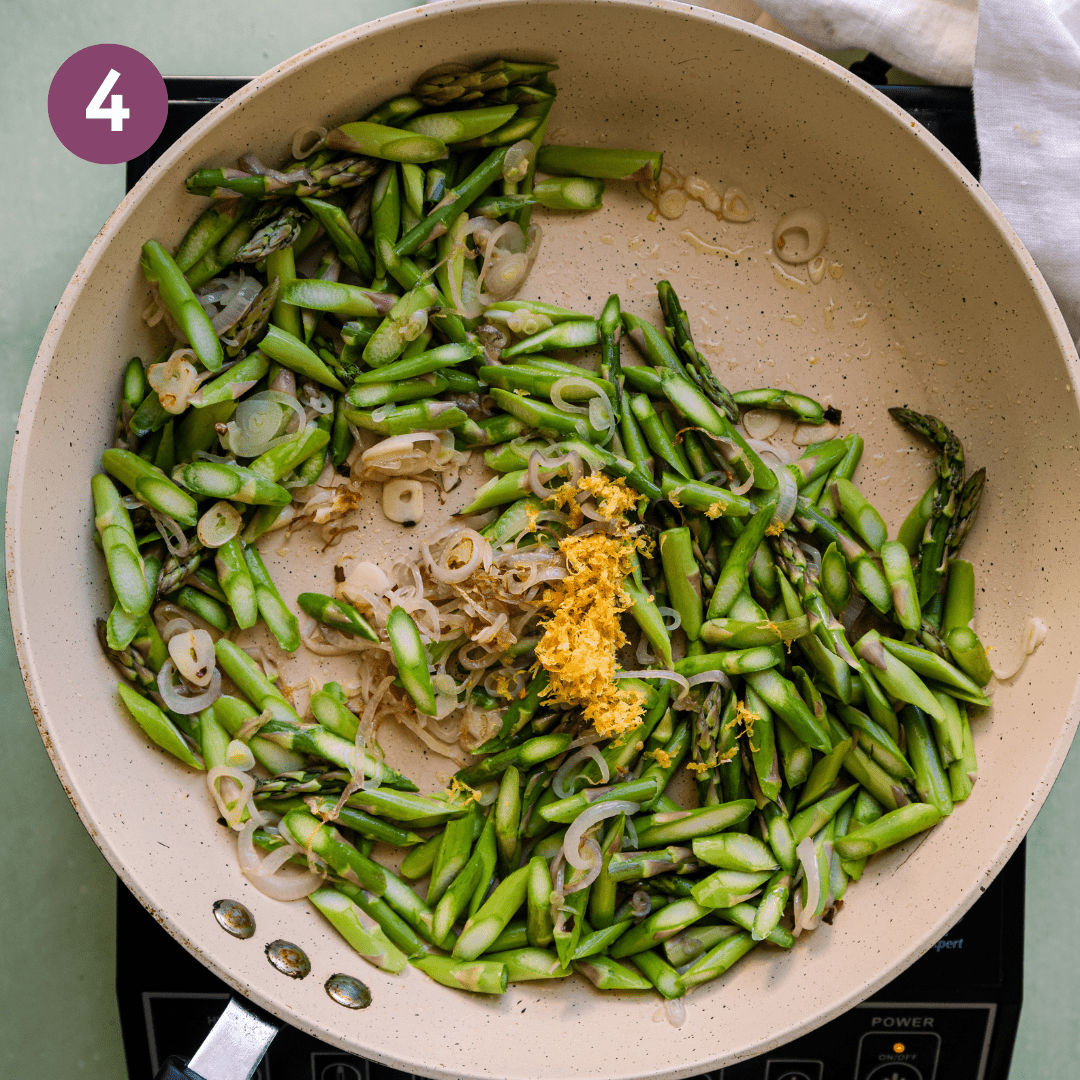
Cook for 3 minutes, until asparagus is crisp-tender. Take off the heat and let sit until the pasta is ready.
Cook the pasta in a pot of boiling salted water. While cooking, prepare the rest of the ingredients. Chop the basil and parsley, slice the olives, crush the walnuts, rinse and drain the white beans (if using).
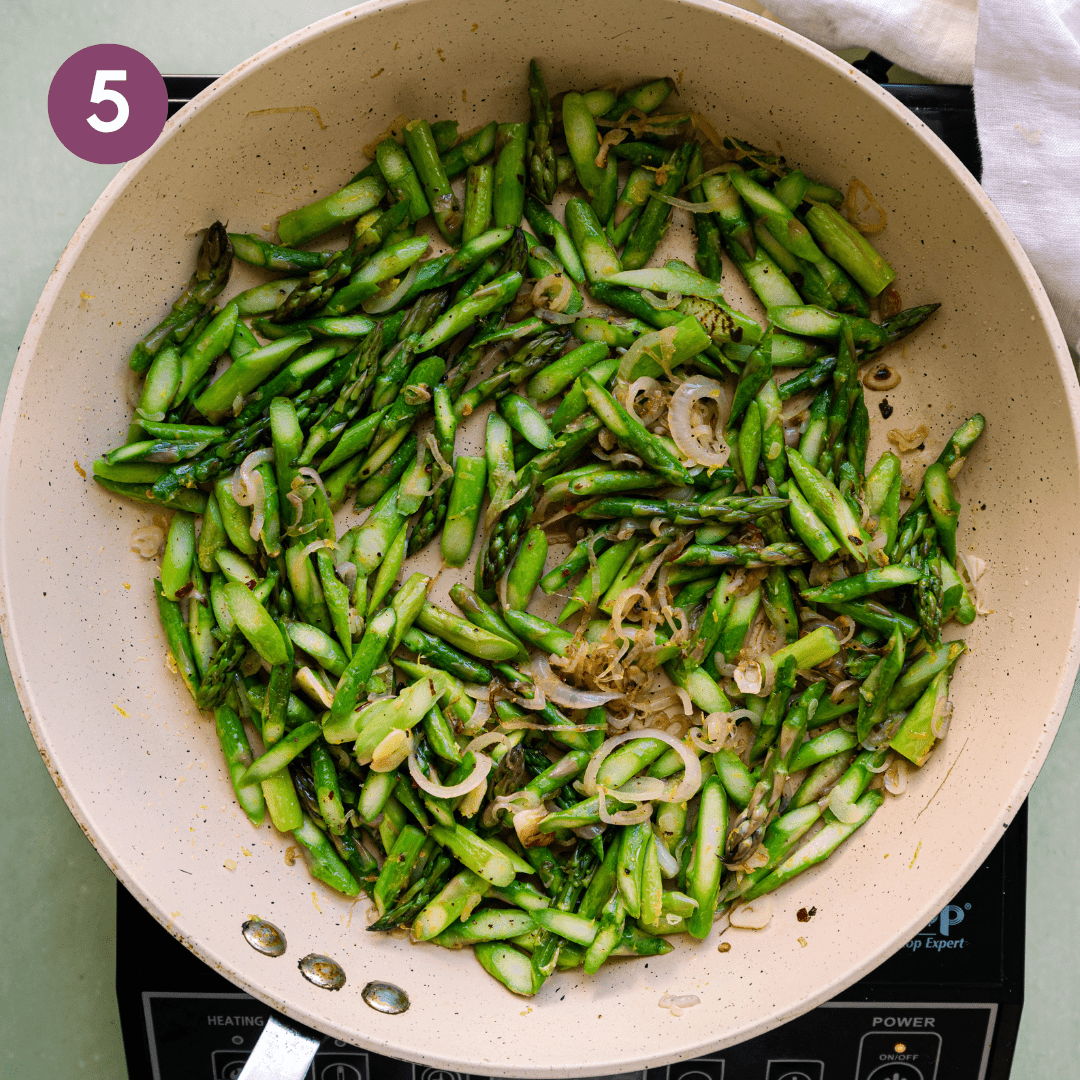
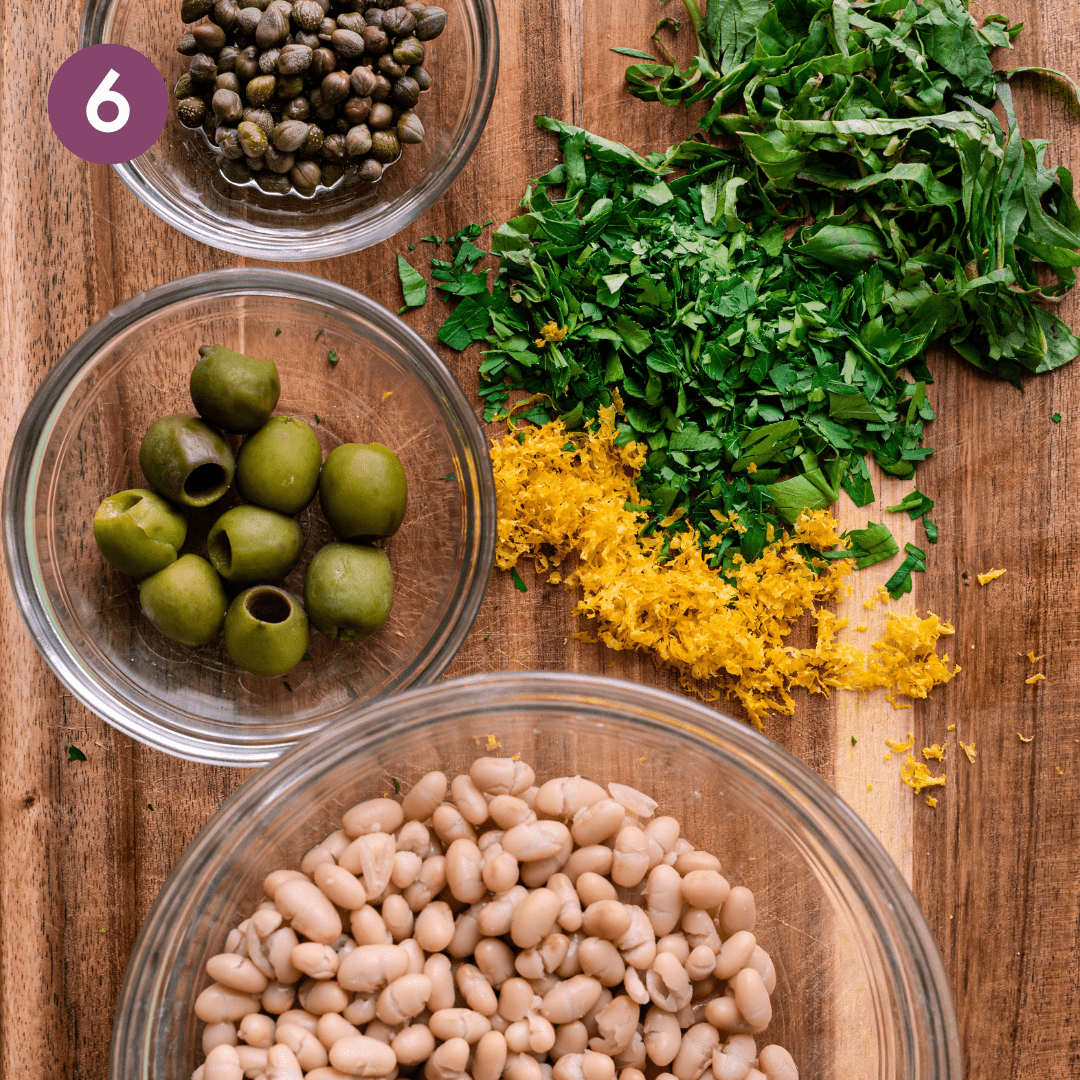
Once the pasta is just al dente, reserve up to 1 cup of the cooking water, then drain (do not rinse!). Transfer the hot cooked pasta and Lemon Sauce to the pan with the asparagus.
Add the crushed walnuts and nutritional yeast.
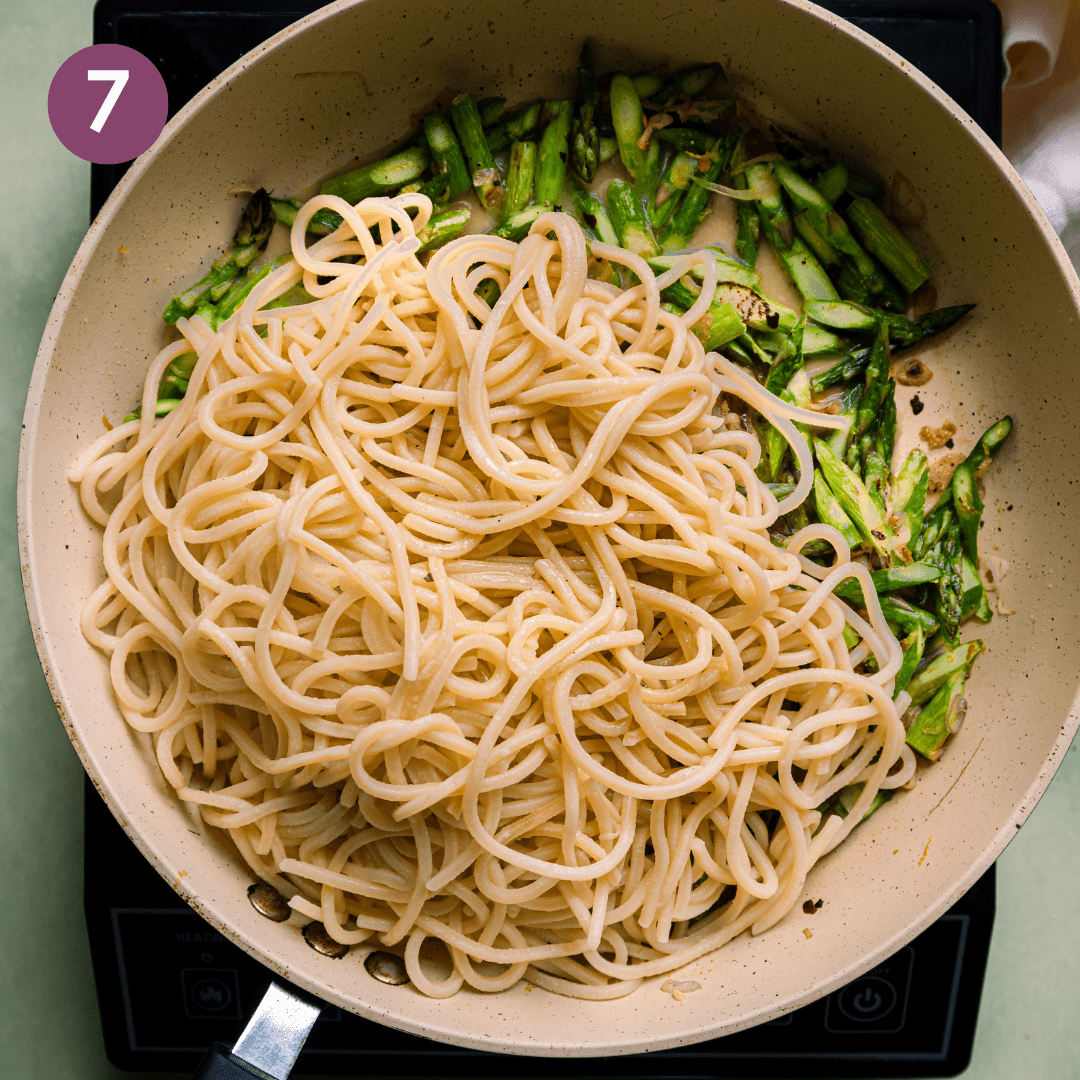
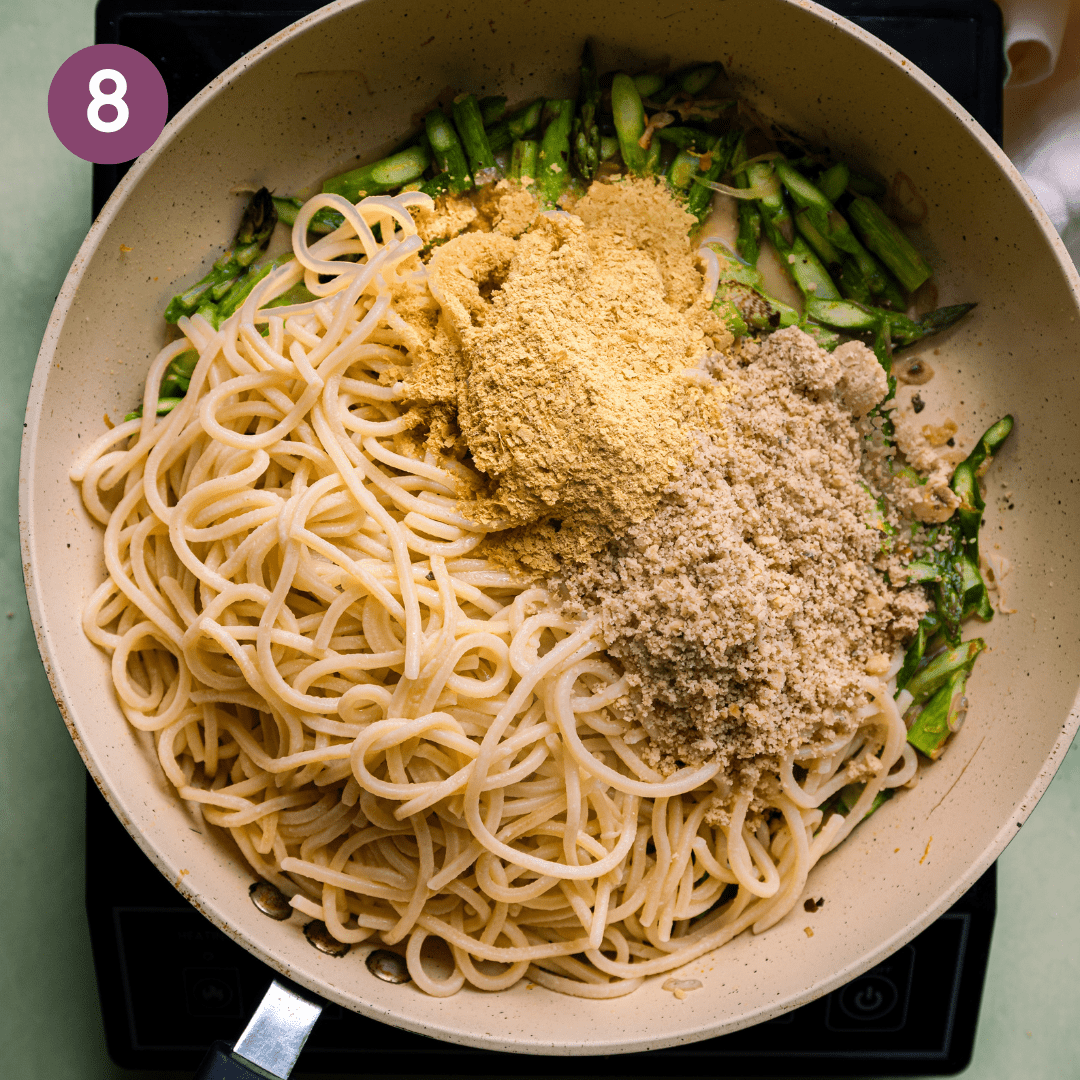
Pour in 1/2 cup (120 mL) of pasta water and return the pan to medium-high heat. Use tongs to toss the mixture quickly and vigorously, until emulsified. Add more pasta water as needed.
Add the remaining ingredients – basil, parsley, capers and olives if using, remaining lemon zest (from one lemon), and white beans (if using).
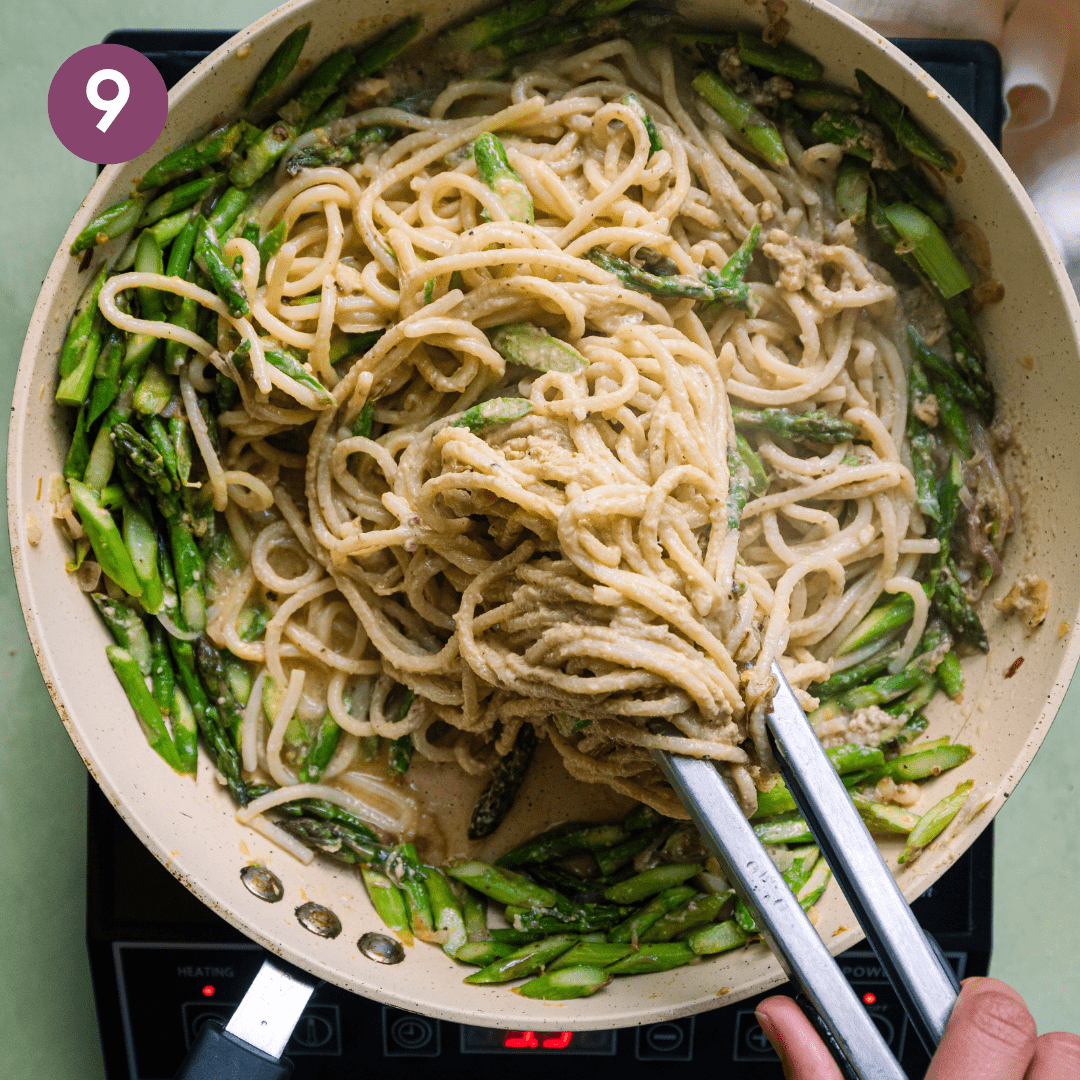
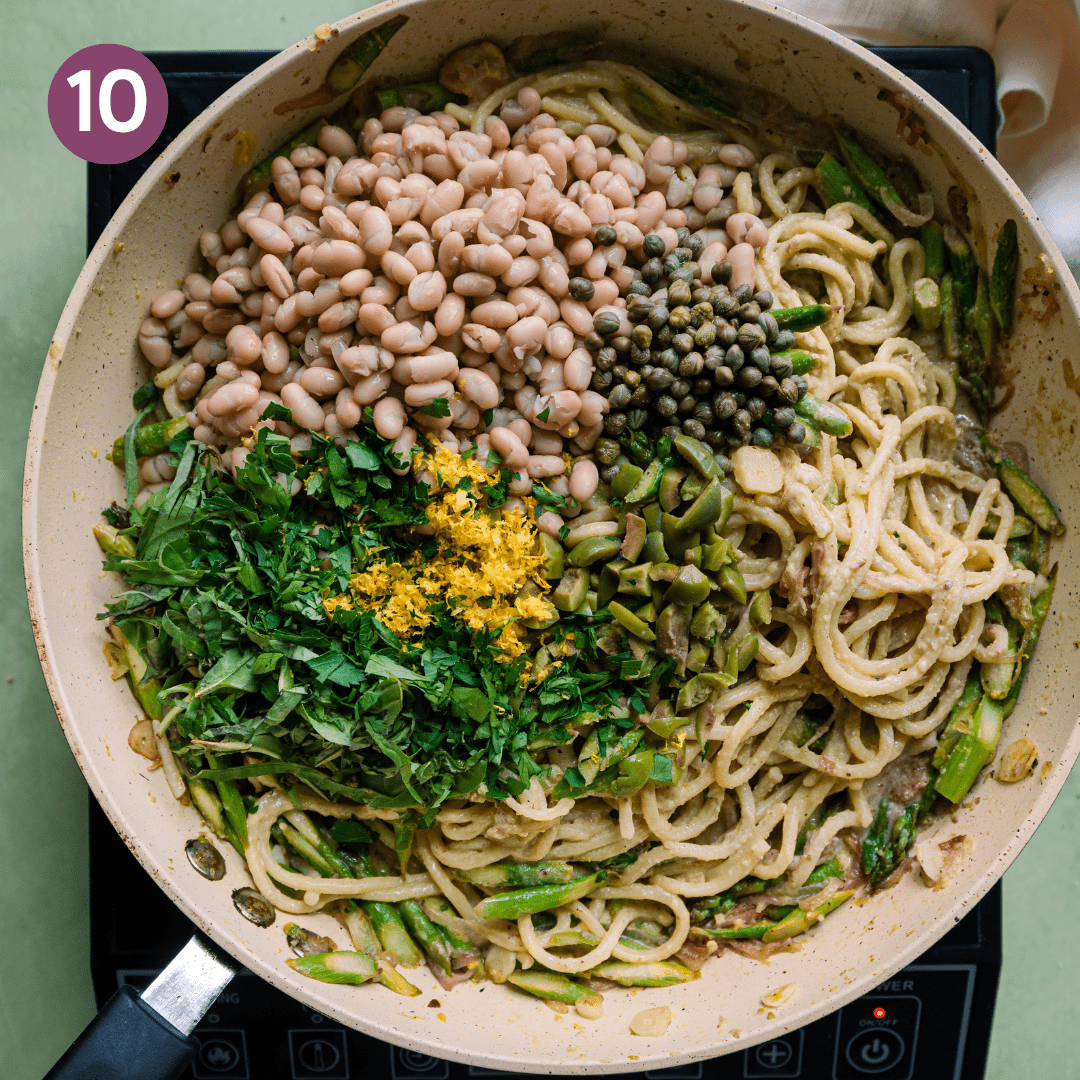
Toss again to combine and briefly cook. Serve warm.
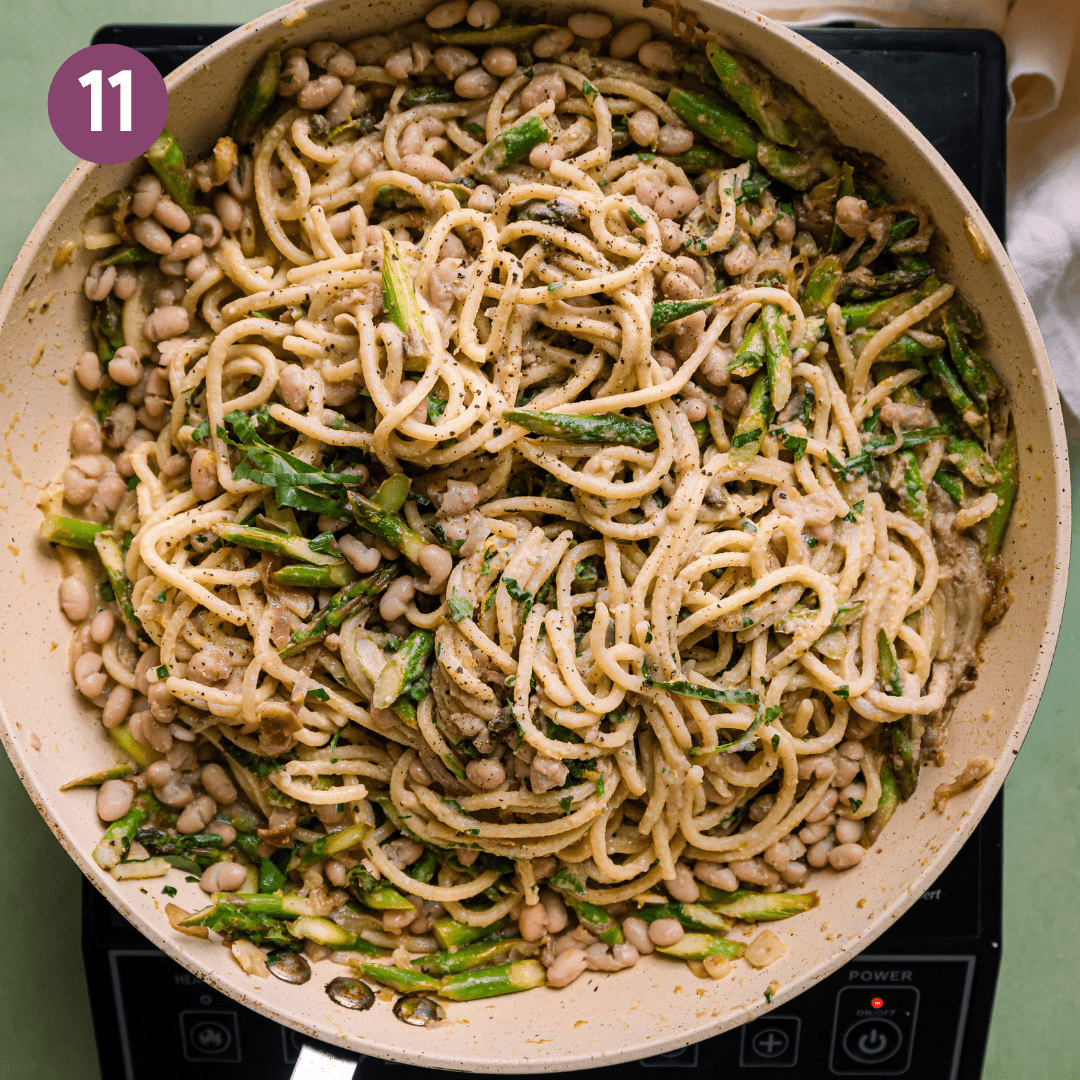
Tips for making this recipe
Use less water than you’d think.
Without any cream or cheese, we need a very starchy pasta water to bind our sauce together.
To achieve this, use a bit less water to cook the pasta than you might typically use. For 10 to 12 ounces (285-340g) of pasta, that translates to about 9 cups (~2.1 liters/quarts) of water.
And of course generously salt the pasta water – about 2 to 3 teaspoons kosher salt (use less if using table salt or sea salt) to ensure the pasta itself has flavor from within.
Cook the pasta until just al dente.
Aim to remove the pasta from the water as soon as it’s al dente, or even a minute beforehand, as the pasta is going to continue to cook in the lemon sauce for a few minutes. Otherwise, the texture might be a bit overdone.
For the sauciest texture, enjoy this pasta shortly after making it. That’s not to say the leftovers aren’t tasty. They are. But this dish is the most luscious when eaten on day one. The color also starts to fade after a few hours.
Choose the right pan.
When cooking the shallots, garlic, and asparagus, use a large 12-inch sauté pan with relatively deep sides, or a Dutch oven. All of the pasta and mix-ins will be added into this pan at the end, so it helps to have a large enough pan to avoid any spills or mess.
Make it quicker with the right tools.
While you can definitely use a sharp knife to slice the shallots and walnuts, you’ll save some time by using (1) a mandoline for the shallots (and garlic, if the cloves are on the large side and you have a handheld mandoline slicer like this); and (2) a spice grinder to pulse the walnuts a few times until mostly crushed.
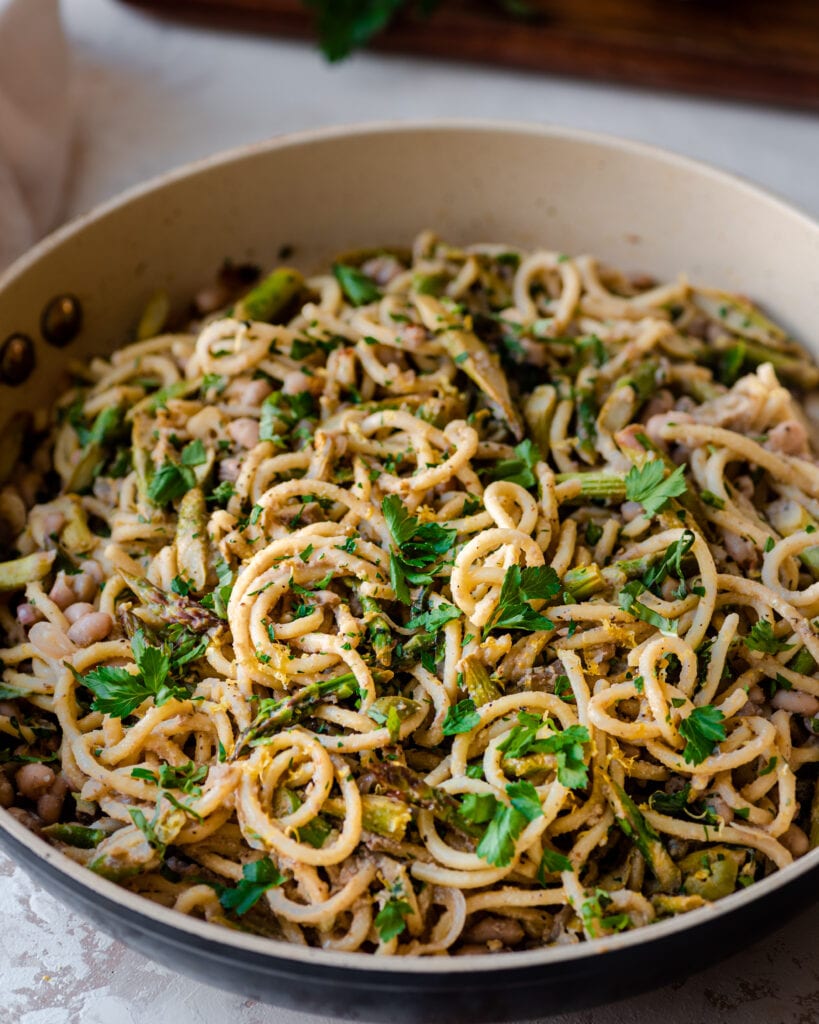
Frequently Asked Questions
Most of us have been taught that to cut asparagus, you bend it until it snaps. And the bottom portion that snaps off is too woody and tough to eat. WRONG!
Instead, use your eyes to see where the asparagus look like they’re starting to get tough, about an inch or two up the ends. Then, you can slice a big batch of them in one fell swoop. This is the technique that the fine people over at Serious Eats also recommend.
Or, if you want to be more precise, you can slice each asparagus spear for this recipe. And once your knife starts to feel some tension, you know that this particular spear has hit its tough end. Watch this video to see how I cut my asparagus for this recipe.
You can, with a few caveats.
First, gluten-free pasta tends to get mushy, so you’ll really need to ensure you stop cooking the pasta once it’s just al dente.
And second, gluten-free pasta tends to be more absorbent, so you may want to add more pasta water (up to 1 full cup) when you coat the pasta.
If you add the white beans to this recipe, this is a complete meal on its own (perhaps only more complete with a crisp glass of white wine).
If you omit the beans, it’s still quite satisfying, but you can serve the pasta along with a salad (a Caesar salad or simple mixed greens work well). Or on the side of blanched or roasted vegetables, such as broccolini/broccoli. For a protein option, a simple white bean salad works great (mix cooked or canned/drained/rinsed white beans with a bit of good-quality extra virgin olive oil, lemon juice, salt, and pepper).
Store in an airtight container in the fridge for 3 to 4 days. The pasta is best shortly after making, when the sauce is creamy and satiny.
I actually prefer leftovers cold over warmed up. If you want to reheat, heat the leftovers in a skillet over medium-low heat. Add a splash of water as needed to thin and toss frequently. If needed, perk the pasta up with some fresh lemon zest and/or juice.
In the mood for even more pasta? I’ve rounded up 30 of the best vegan pasta recipes from around the web! There are so many great choices, though I’m partial to the Lentil Bolognese during winter and the Vegan Pasta Salad in summer. Check it out!
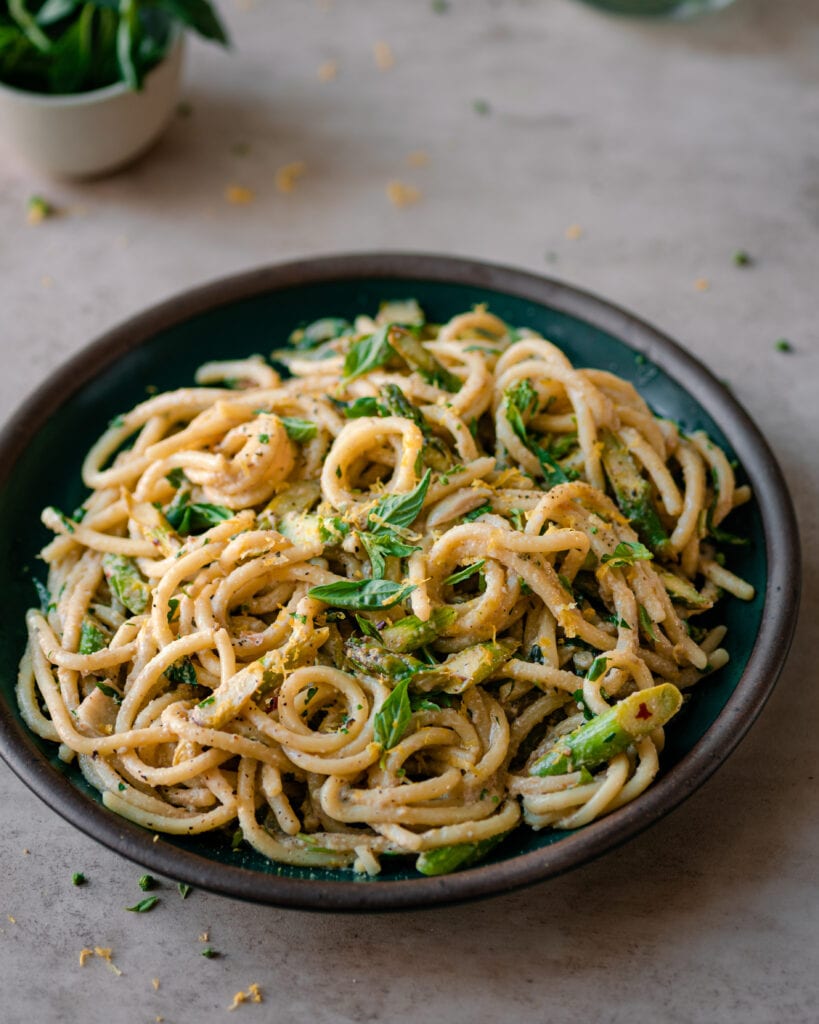
If you love this Lemon Asparagus Pasta, please be sure to leave a rating and review below! It’s always much appreciated :) And tag me on Instagram – I love seeing your remakes!
Lemon Asparagus Pasta
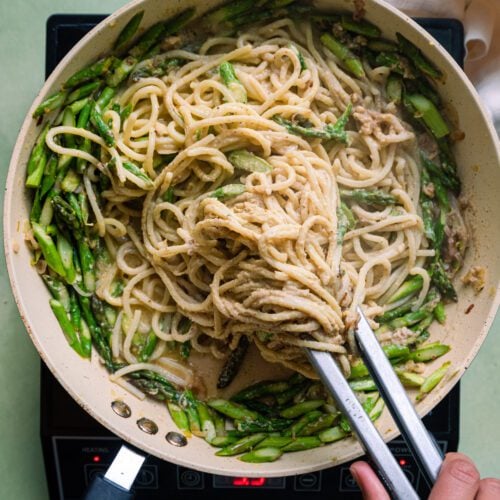
Ingredients
- 10 ounces (285g) of spaghetti, bucatini, linguine, or fettuccine (see Note 1)
- 2 medium-large lemons (see Note 2)
- 6 1/2 tablespoons extra virgin olive oil, divided
- Kosher salt and freshly cracked black pepper
- 1/2 teaspoon Dijon mustard
- 2 medium shallots, thinly sliced
- 4 garlic cloves, thinly sliced
- ¼ teaspoon red pepper flakes (optional)
- 1 bunch of asparagus (about 14 ounces), sliced thinly on a bias into 1-inch (2.5 cm) pieces
- ½ cup (60g) toasted walnuts, finely crushed (see Note 3)
- 3 tablespoons nutritional yeast
- ½ cup (8g) Italian flat-leaf parsley, (leaves and tender stems), chopped
- ½ cup (8g) fresh basil leaves, slivered
- 2 tablespoons capers, drained (optional)
- ¼ cup (30g) Castelvetrano olives, sliced in half (7 to 9 olives) (optional, see Note 4)
- 1 (15-ounce/425g) can of navy beans or other white beans rinsed and drained (optional, for a main meal)
Instructions
- Bring a large pot of water to a boil for the pasta.Tip: Don’t use too much water, otherwise the pasta water won’t be very starchy. I recommend about 9 cups (~2.1 L) of water for 10 ounces of pasta. Once the water is nearly boiling, add a generous amount of salt (~1 TBSP kosher salt). Add the pasta and cook according to the package directions, stirring occasionally, until just al dente. Drain the pasta, reserving 1 cup (240 mL) of the pasta water.
- Zest the lemons and divide the zest into two piles. Set aside.
- Meanwhile, make the Lemon Sauce. In a mason jar, combine 5 tablespoons (75 mL) of the lemon juice, 5 tablespoons (70g) of the extra virgin olive oil, 1/2 teaspoon Dijon mustard, 1 teaspoon kosher salt, and black pepper to taste. Shake until emulsified.No jar? Just whisk all the ingredients in a bowl until emulsified.
- Cook the asparagus. Meanwhile, heat 1 ½ tablespoons olive oil in a 12-inch sauté pan or Dutch oven over medium heat. Once warmed, add the shallots and garlic. Cook for 2 to 3 minutes, until the garlic is just golden, stirring frequently to prevent burning. Add the red pepper flakes (if using) and cook for 30 seconds. Add the asparagus and one half of the lemon zest. Season with a few pinches of salt and pepper. Cook for 3 minutes until the asparagus is crisp-tender. Remove from heat and set the pan aside until the pasta is done.
- Add the hot cooked pasta and the Lemon Sauce to the asparagus mixture, along with the crushed walnuts and nutritional yeast. Add ½ cup (120 mL) of pasta water. Return the pan to medium-high heat. Use tongs to vigorously toss everything together, shaking the pan as you go, adding more pasta water as needed, until the sauce is emulsified and clings to the pasta.
- Add the remaining half of the lemon zest, basil, parsley, and the capers, olives, and white beans, if using. Toss again and briefly cook for 30 to. 60 seconds. Sprinkle with a pinch or two of salt and pepper and finish with a nice drizzle of olive oil. Serve immediately.
Notes
- You can use up to 12 ounces (340g) of pasta but it’s sauciest with 10 ounces (285g).
- The lemons should feel heavy for their weight. If you can’t find lemons that are medium-large, buy an extra third lemon to ensure you get enough zest and juice.
- To toast raw walnuts, add to a dry skillet over medium heat and cook, stirring occasionally, until a bit browned and fragrant, 4 to 5 minutes. Or roast a large batch on a sheet pan in the oven at 350ºF/175ºC for 8 to 10 minutes, tossing halfway. You can also use raw walnuts, but you’ll get more flavor from toasted. To crush walnuts, the quickest way is to add to a spice grinder and pulse several times. Otherwise, very finely mince with a knife.
- If your olives are already pitted, slice them in half. If they have the pits inside, here’s how to remove the pits.




Wow. This recipe is delicious, such depth of flavor while still being light and lemony. It halved easily and I used cellentani with great results. I’ll absolutely make this again. Thank you!
Leah, So glad to hear you loved this recipe!
I made this twice already and it always turns out amazing. It’s sooo packed with fresh flavors ! It’s one of my all time favorites.
Nadia, So glad to hear you loved this recipe!
This pasta recipe was nothing short of outstanding!!! Very creamy, luxurious and lemony. I haven’t made a recipe of yours that I didn’t love! 💕 P.S. I tell everyone about you.
Awesome, Jeri. Thanks for your comment and for taking the time to review! We are honored you share Rainbow Plant Life with people in your life :)
Delicious!!
Awesome, Erin. Thanks for your comment and for taking the time to review!
I just made this pasta dish after watching your youtube. Very flavorful and delicious. My husband loved it too. Thank you so much! Can’t wait to try your other recipes👏🏼
Awesome, Jay. Thanks for your comment and for taking the time to review!
Wow!!! So delicious! Decided to cook this for my bday. I’m not a huge fan of cooking, but when a meal comes out like this?? So worth it!! I subbed pecans for walnuts & didn’t have basil. But otherwise followed recipe. Took me longer to make than I thought it would, but again so yummy!!
Kathleen, So glad to hear you loved this recipe!
Just made this for the first time, it is absolutely delicious. It turned out great and my family loved it. I substituted hemp seeds for the walnuts due to nut allergies here. Thank you so much for a delicious recipe!
Thanks for sharing, Jodi!
This is an amazing meal! I’ll definitely be making this again.
Awesome, Zanna. Thanks for your comment and for taking the time to review!
Just made this for the umpteenth time, because I had leftover asparagus, and everything else in this recipe is always on hand. This time, since my parsley and basil plants weren’t ready for harvesting, I chiffonaded some baby spinach and augmented with a snowstorm of dried basil. My husband loved it, even after I told him I sneaked spinach into his dinner (again). I heart this recipe so much!
Awesome, Sara. Thanks for your comment and for taking the time to review!
Restaurant quality pasta dish! Delicious! My husband and I really enjoyed this. Thank you!
Sofia, So glad to hear you two love this recipe!
I was worried that all the acidic and vinegary components of the dish would result in a mouth-puckering outcome, but the flavors worked together perfectly! Would be good as a cold pasta salad as well, with shorter/smaller noodles.
Kimberly, So glad to hear you loved this recipe!
This was very good, thank you!
Not super important, but I am wondering if you know why my white wheat pasta noodles turned brown? They looked like whole wheat noodles at the end.
Hi Rebecca, we are so happy you loved the recipe! That’s so odd your pasta noodles changed color, what type of pan did you use to cook them?
It was just a normal nonstick skillet!
Beautiful dish that is surprisingly light, yet rich and satisfying. Another bonus: tastes great hot and cold as well !
Awesome, Isabelle. Thanks for your comment and for taking the time to review!
Third time I made it…today I doubled the lemon zest and juice and enjoyed the results MUCH more. Love your recipes Nisha! Thank you for another winner!
Thanks for sharing, Christine!
This was delicious! Unfortunately, I used a cast iron pan to sauté the asaparagus, lemon sauce and other ingredients. It turned the pasta a bit dark, maybe a reaction between the cast iron and the lemon juice? Next time, I’m using an enamel or a stainless pan. And there will be a next time since this was sooo good!
Loved the recipie as always Nisha. My pasta tasted a little lemon heavy. Can you suggest any alterations to make more balanced.
Thank you.
Hi Shruti, good to hear you enjoyed the pasta! It is a lemon asparagus pasta, so it’s meant to be quite lemon heavy. You can try using a greater ratio of olive oil to lemons next time, or you could add more shallots or salt/capers/olives. We hope you get it perfect next time! :)
My partner can’t eat walnuts, would pecans be a good substitute for them?
Hi there Angela, yes pecans would work!
We love this recipe! Tastes like restaurant cooking right at home. Thank you!
Thank you for the wonderful review, Sarah!
This was amazing! I didn’t have asparagus so I used mushrooms instead – it was so simple yet yummy!!!
Love that it’s so easy to make no speciality vegan ingredients!
Thanks for the lovely feedback, Aman!
Oh my goodness! I just watched your live show and cooked along with you since I had most of the ingredients. I could eat this pasta every single day! The only change I made was adding a little jalapeno pickle brine in place of the olives and capers since I didn’t have either of those. Oh soooo delicious! If you enjoy pasta, you should definitely try this one.
Awesome, Susan. Thanks for your comment and for taking the time to review!